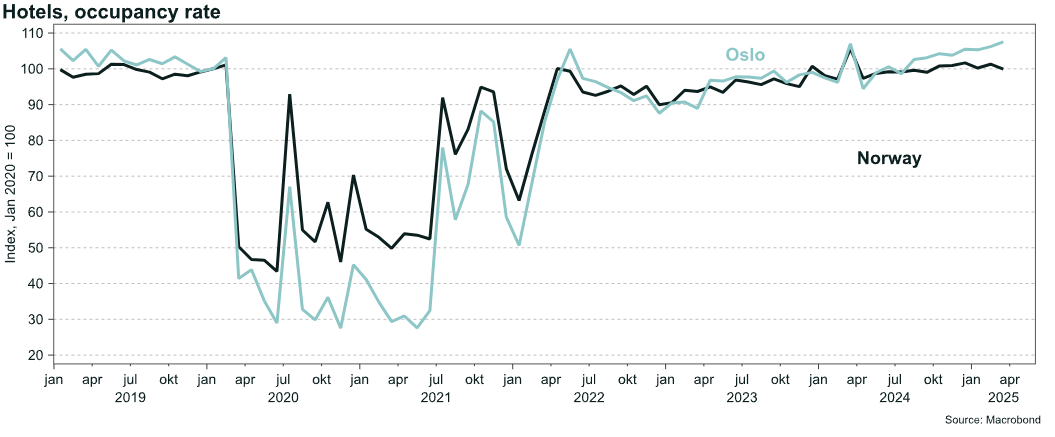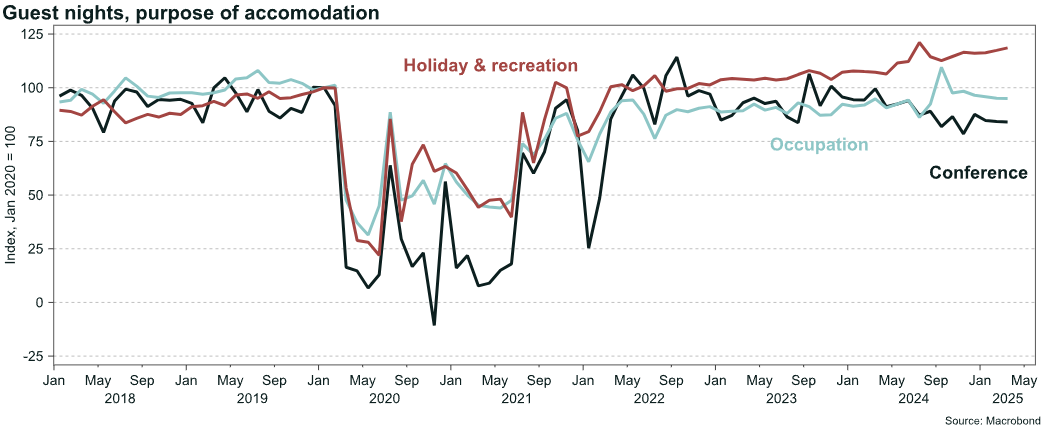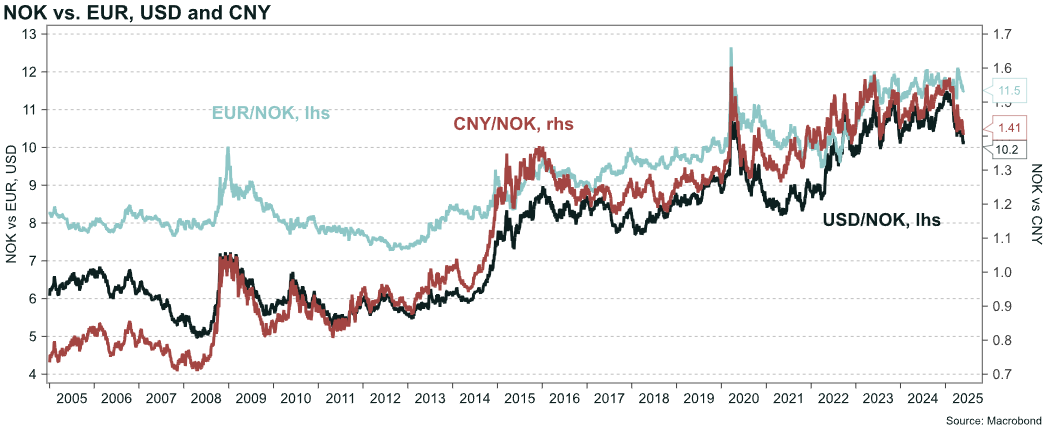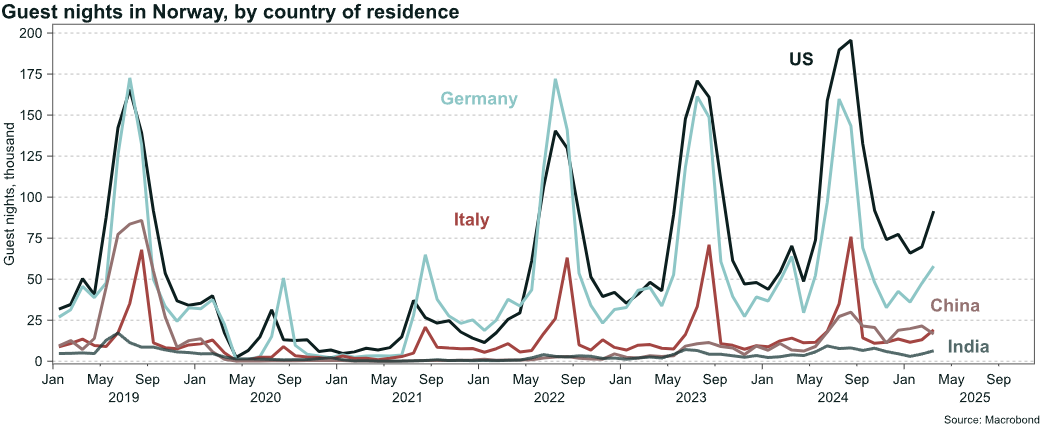
Market Views, Macro | Trends Favour Norway as a Destination
Hotel occupancy rates in Norway have rebounded well following the pandemic, with holiday-related stays now significantly higher than pre-pandemic levels. A weak Norwegian krone, combined with global trends that favour Norway as a destination, is likely to drive further growth in tourism to Norway over the coming years.
Summary
- Visitor numbers at Norwegian hotels have recovered strongly since the pandemic, with holiday-related occupancy now significantly higher than pre-pandemic levels.
- Several trends are contributing to Norway’s growing appeal as a travel destination, including a weak Norwegian krone, which makes Norway more attractive to both domestic and international tourists.
- In addition, climate change and a growing demand among travellers for stability and safety are expected to further support the growth of tourism to Norway in the coming years.
Strong Hotel Performance in Norway
During the pandemic, visitor numbers to Norwegian hotels dropped sharply, but have since recovered. Nationally, hotel occupancy has returned to pre-pandemic levels, while in Oslo, visitor numbers are now approximately 10 per cent higher than before the pandemic.

However, on a national level, business-related stays – including those connected to conferences and corporate travel – have declined somewhat compared to the pre-pandemic period. Conversely, leisure and holiday stays have continued to rise, with occupancy in this segment now around 20 per cent higher than before the pandemic. According to Statistics Norway (SSB), many Norwegians discovered the appeal of domestic travel during the pandemic, and this increased interest in holidaying within Norway has persisted.
Leisure travel is typically influenced by household finances. According to Virke, at the beginning of 2025, it was expected that Norwegians would spend a record amount on holidays this year, driven by increased purchasing power due to real wage growth and lower interest rates. Although there is now some uncertainty regarding the short-term trajectory of interest rates, real wage growth and further strengthening of purchasing power are still anticipated this year.

A Weak Norwegian Krone
The Norwegian krone has weakened significantly in recent years. All else being equal, this makes it more affordable for international tourists to visit Norway, while making foreign travel more expensive for Norwegians. A weaker krone thus increases Norway’s attractiveness as a destination, both for foreign and domestic tourists.
Historically, the krone’s depreciation began around 2013, when oil investments peaked as a share of the Norwegian economy. Since then, the currency has followed a generally weakening trend. From the beginning of 2013 to today, the krone has depreciated by approximately 60, 70, and 90 per cent against the euro, Chinese yuan, and US dollar, respectively. Going forward, the krone may strengthen somewhat, but it is widely expected to remain at a lower level than in previous decades.

Other Favourable Trends
Beyond currency effects, several other factors contribute to Norway’s attractiveness as a tourist destination. Norway’s cool climate and reputation for stability and safety are increasingly important competitive advantages.
The global travel trend of seeking safety and security – already well established – has been further reinforced post-pandemic. Travellers increasingly prioritise destinations where they feel secure and able to relax, and practical considerations such as easier access to travel insurance also play a role. According to organisations such as the World Tourism Organization and Euromonitor, safety is among the most important factors influencing tourists’ choice of destination. Travellers assess political stability, crime rates, and healthcare infrastructure, with families, solo female travellers, and older tourists placing particular emphasis on safety.
Norway is internationally recognised as one of the safest countries in the world to visit, and consistently ranks highly on indices such as the Global Peace Index and the World Happiness Report. The country boasts low crime rates, stable institutions, and robust healthcare infrastructure. In an era marked by geopolitical instability and military build-up, Norway is expected to remain an attractive destination for international tourists in the years ahead.

Another trend working in Norway’s favour is climate change. “Coolcation” – a growing travel trend – involves tourists actively seeking out cooler destinations for their holidays. This trend has been fuelled by increasingly frequent heatwaves and extreme summer temperatures in Southern Europe. European travel agencies report that the Nordic countries, including Norway, are becoming increasingly popular among summer tourists as a result. According to VisitNorway, the "Coolcation" trend has led to a marked increase in international summer visitors in recent years. Given the long-term outlook for climate change, this trend is expected to strengthen further going forward.
Conclusion
Hotel occupancy in Norway has seen a solid recovery post-pandemic, with holiday and leisure travel now significantly exceeding pre-pandemic levels. A number of trends are working in Norway’s favour as a destination, and both a weak krone, climate change, and tourists’ increasing demand for safety and stability are likely to support continued growth in Norwegian tourism in the coming years.
Read the CRE analysis here: Market Views, CRE | Hotels Emerging as an… | Akershus Eiendom